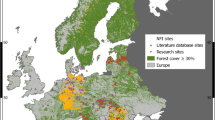Abstract
Temperate forests currently cover about 600 MHa, about half of their potential. Almost all these forests have been directly impacted by humans. The total living biomass in trees (including roots) was estimated to contain 33.7 Gt C. The total C pool for the entire forest biome was estimated as 98.8 Gt. The current net sink flux of biomass was calculated at 205 Mt yr1, with a similar amount removed in harvests for manufacture into various products. The major cause of this C sink is forest regrowth. Forest regrowth is possible because fossil fuels are the major source of energy in temperate countries, instead of fuelwood. Future C in these forests will be greatly influenced by human activity. Options to sequester more C include conservation of forest resources, activities that increase forest productivity such as adopting rotation ages to optimize C production, afforestation, improvement of wood utilization, and waste management.
Access this chapter
Tax calculation will be finalised at checkout
Purchases are for personal use only
Preview
Unable to display preview. Download preview PDF.
Similar content being viewed by others
References
Armentano, T.V., and Ralston, C.W.: 1980, The role of temperate zone forests in the global carbon cycle, Can. J. of Forest. Res. 10, 53–60.
Birdsey, R.A., Plantinga, A.J., and Heath, L.S.: 1993, Past and prospective carbon storage in United States forests, For. Eco. Manage. 58, 33–40.
Birdsey, R.A.: 1992, Carbon storage and accumulation in United States forest ecosystems, Gen. Tech. Rep. WO-59, U.S. Department of Agriculture, Forest Service, Washington, DC, 51 p.
Davis, M.B., and Zabinski, C.: 1992, Changes in geographical range resulting from greenhouse warming: effects on biodiversity in forests, in R. Peters and T. Lovejoy (ed), Global warming and biological diversity,Yale University Press, p. 297–308.
Deutscher Bundestag (ed.): 1990, Protecting the tropical forests: a high priority task, translated by G. Woods-Schank, Bonn, Germany, 968 p.
Eamus, D., and Jarvis, P.G.: 1989, The direct effects of increase in the global atmospheric CO2 concentration on natural and commercial temperate trees and forests, Adv. Ecol. Res. 19, 1–55.
Heath, L.S., and Birdsey, R.A.: 1993, Carbon trends of productive temperate forests of the coterminous United States. J Air,Water, and Soil Pollution, In press.
IPCC: 1990, Climate change, the IPCC scientific assessment, University Press, 365 p.
Kurz, W.A., Apps, M.J., Webb, T. M., and McNamee, P.J.: 1992, The carbon budget of the Canadian forest sector: Phase 1., Forestry Canada, Northwest Region, Northern Forestry Centre, Edmonton, Alberta, Inf. Rep. NOR-X-326, 93 p.
Mather, A.S.: 1990, Global forest resources, Timber Press, Portland, OR, 341 p.
MacCleery, D.W.: 1992, American forests, a history of resiliency and recovery, USDA Forest Service in cooperation with Forest History Society, SF-450, 59 p.
Peters, R.L, and Darling, J.D.S.: 1985, The greenhouse effect and nature reserves, BioScience 35, 707–717.
Sedjo, R.A.: 1992, Temperate forest ecosystems in the global carbon cycle, Ambio 21, 274–277.
Turner, D.P., Lee, J.P., Koerpner, G.J., and Barker, J.R. (eds): 1993, The forest sector carbon budget of the United States: carbon pools and flux under alternative policy options, U.S. Environmental Protection Agency, Office of Research and Development, Washington, DC, EPA/600/3–93/093, 202 p.
UN-ECE/FAO: 1992, The forest resources of the temperate zones: general forest resource information,Vol. 1, New York, 348 p.
Author information
Authors and Affiliations
Editor information
Editors and Affiliations
Rights and permissions
Copyright information
© 1993 Springer Science+Business Media Dordrecht
About this chapter
Cite this chapter
Heath, L.S. et al. (1993). Contribution of Temperate Forests to the World’s Carbon Budget. In: Wisniewski, J., Sampson, R.N. (eds) Terrestrial Biospheric Carbon Fluxes Quantification of Sinks and Sources of CO2 . Springer, Dordrecht. https://doi.org/10.1007/978-94-011-1982-5_4
Download citation
DOI: https://doi.org/10.1007/978-94-011-1982-5_4
Publisher Name: Springer, Dordrecht
Print ISBN: 978-94-010-4875-0
Online ISBN: 978-94-011-1982-5
eBook Packages: Springer Book Archive




